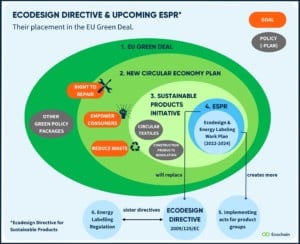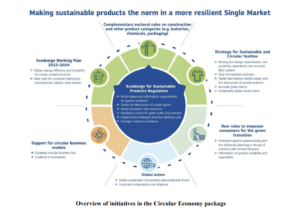What is the Ecodesign Directive?
The EU’s Ecodesign Directive (2009) prescribes energy-related Ecodesign criteria for certain products and communicates this through energy labels. So far, it saved consumers 120 Billion euros of energy expenditure (!!), and lowered energy consumption of the regulated products by 10% in 2021.
The Ecodesign Directive is based on the sustainable design approach: Ecodesign. Ecodesign minimizes the life-cycle environmental impacts of a product through design solutions driven by environmental data (measured with LCA). Think of using different materials, energy efficiency, durability, repairability, etc.
What is the Ecodesign for Sustainable Products Regulation (ESPR)?
The proposed “Ecodesign for Sustainable Products Regulation” (ESPR) will replace the current EU Ecodesign Directive. It will introduce more extensive Ecodesign requirements for many more product groups. Resulting in consequences for a wider range of companies.
In this article you learn:
- How the ESPR relates to the EU Green Deal policy framework (+ a nice infographic)
- The process and outcomes of ESPR implementation so far;
- Which confusing concepts have nothing to do with Ecodesign Directive/ESPRS;
- How companies can prepare for the ESPR.
How the ESPR relates to the EU Green Deal
The Ecodesign directive and ESPR sit in a jungle of regulations and plans – all part of the European Green Deal.
Let’s go through all the layers. This first section of terms deals with the outer layers – covering the green part in Image 1.
1. EU’s Green Deal – The big idea
The EU Green Deal is a policy package to make the EU carbon neutral by 2050. Immense funds of about 1 trillion euros are available for it. Its promises range from decoupling economic growth from resource use, over nature restoration, to improved public health and well-being.
2. The circular economy – A plan for action
One policy in the EU Green Deal is the Circular Economy Action plan. The circular economy action plan in turn has different policies, e.g. on empowering consumers in sustainable choices, reducing waste, and: the “sustainable products initiative”.
3. Sustainable Products Initiative – Getting down to business
The Sustainable Products Initiative’s goal is to “make sustainable products the norm”. The ESPR is the main policy instrument here. The ESPR will be a regulation, thus: binding for EU member states. We’ll get to know it deeply in the next section.
The Sustainable Products Initiative is implemented further through the “EU Strategy for Sustainable and Circular Textiles” and the revision of the Construction Products Regulation (Image 1). They cover more product-specific rules, while the ESPR covers environmental aspects.

The Ecodesign for Sustainable Products Regulation (ESPR)
Now let’s zoom in on the ESPR: It is placed in the inner layers of the European Green Deal. The blue parts in Image 1.
4. ESPR will replace Ecodesign Directive
At the current time of writing (12/2022) the Ecodesign Directive regulates 31 product categories, posing mainly energy-related criteria. However, the new ESPR wants to cover the “broadest possible range of products” with more diverse Ecodesign criteria. This means the EU still has to draft new regulations and perform many studies before the ESPR enters into force. This is called the Ecodesign and Energy Labeling Work Plan.
5. Implementing acts
Each regulated product group in the Ecodesign Directive has its own “implementing act”. This is a piece of law, that makes the Ecodesign criteria mandatory. Currently, the EU is developing the implementation of acts for new product groups and revising old ones. The new acts still enter into force under the current Ecodesign directive. Once the ESPR enters into force, it will take over these acts and replace the current Ecodesign directive.
Next to Ecodesign criteria, the ESPR will introduce a digital product passport for all regulated products. This makes information available to supply chain actors, regulators, and consumers alike. It will likely also monitor- or even prohibit the destruction of unsold consumer goods. Some other ESPRS sub-goals are visible in the blue core in Image 2 below.
6. Energy Labels
The Ecodesign Directive and the Energy Labelling Regulation are “sister directives”. They are often mentioned and worked on together.
Product groups with energy labeling requirements also have Ecodesign ruling. But not every product group with Ecodesign ruling needs/ is suitable for energy labeling.
This is how the EU puts it:
- “The Ecodesign Directive (2009/125/EC) – the tool for making products more energy efficient.
- The Energy Labelling Regulation (EU) 2017/1369) – the tool through which the consumer can recognize the best-performing products”
On March 1, 2022, energy labeling applied to 15 product groups.

Current plans for the ESPR
The long road toward the final ESPR is guided by the Ecodesign working plans. These periodically take stock of the progress made and establish priorities.
Some of the insights of the current working plan 22-24 for the coming years are:
- Coming soon: Implementing acts on mobile phones and tablets, and computers and computer servers
- 31 product categories to be assessed next -first those* with the highest energy or material efficiency potentials. Regulations might arrive by 2030.
- More focus on non-energy related Ecodesign criteria such as durability, reparability, recyclability, ease of end-of-life disassembly and reuse, recycled content, etc.
- Progress made on requirements for Solar PV-related products.
- A repair score was developed, and adding this to energy labels of “relevant products” (e.g. consumer electronics) is considered.
- Priority: rescaling Energy Labels and adding onto them the European Product Registry for Energy Labelling (EPREL) as a QR code.
*Priority products for the next years (working plan section 4.4): low-temperature emitters, professional laundry machines, and dishwashers, universal external power supplies, and electric vehicle chargers.
How to prepare for the ESPR
The ESPR will pose Ecodesign criteria for as many products as possible. However, in the next few years, it will be implemented for only a limited range of energy-intense products. Our tip: find out if your products are among them!
Make LCAs of your products
The environmental impact of the whole life product cycle is a prominent theme in the EU’s environmental regulations. The talk is of a “whole life cycle approach to product regulation” in the ESPR proposal. LCA is currently only prescribed in the EU’s Product Environmental Footprint (PEF) method – which falls outside of the ESPR. The EU is vague about if- and how it wants LCA as a methodology applied in the context of the ESPR. But it’s very likely it will.
As we know, Ecodesign is all about reducing LCA impacts. Therefore, it’s incredibly likely that the environmental data required by the ESPR will be LCA data. Prepare and already take steps towards Ecodesign (rules) with your product. Measure the environmental footprint of your product with LCA.
Ecochain is an easy LCA tool, specifically created for Ecodesign. Have a look at Ecochain here.
References:


